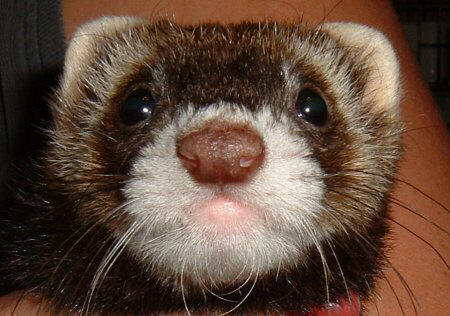
 |
|||||
|
|
 |
|
||||||
Breeding Your Ferret :: FerretIf you’re thinking of breeding your ferret – who is unarguably the most adorable, gorgeous ferret in the world and can only add to the genetic wonder of the species – think again.  Unless you’re a trained professional breeder with deep pockets and extensive knowledge
of ferret reproduction and neonatal care, attempting to breed the animal is a bad
idea. Unless you’re a trained professional breeder with deep pockets and extensive knowledge
of ferret reproduction and neonatal care, attempting to breed the animal is a bad
idea.
“There are some benefits if you know what you’re doing,” says Kim Schilling, director of the Animals for Awareness ferret shelter in suburban Chicago and author of Ferrets for Dummies. “There are some wonderful breeders out there who put out great, beautiful, wonderfully tempered ferrets. But for the average person…” Hard to Find Unaltered Ferrets The first hurdle is even finding two unaltered ferrets to breed. Virtually all ferrets adopted from shelters or pet stores are spayed or neutered. The only way to get a sexually intact ferret is from a private breeder, and most breeders insist buyers sign a contract agreeing to alter the animal. There are good reasons for this. Intact male ferrets become extremely aggressive when around sexually receptive females, and intact females, if not bred, maintain very high levels of estrogen that can cause death from aplastic anemia. But say you’ve lined up two potential mates. From an ethical point of view, just because they can doesn’t mean they should. Indiscriminate breeding goes against the International Federation of Ferret Breeders Code of Ethics. Breeders typically breed for specific traits, and unless this ferret union appears likely to produce top-quality babies, it is discouraged. “Only a really very small percentage of ferrets are really worthy of breeding,” Schilling says. The Mating The breeding itself is not for the faint of heart, she warns. The act can be pretty rough. “The male is definitely not very gentle with the female. He grabs her by the neck and can draw blood and leave wounds. She’s usually protesting. It’s a Neanderthal type of courtship.” The Pregnancy Pregnancy typically lasts 38 to 44 days, with litters ranging between 2 and 17 kits. Pregnancy is not usually difficult, though the female – called a “jill” – will have a few special needs during this time, including increased protein requirements and a nest box awaiting her young. A variety of complications can occur just before or just after birth, however. Infections of the mammary glands or uterus are not uncommon. New mothers’ health must be watched carefully. Once labor begins, birth occurs quickly. The newborns come out in a mass of kits and umbilical cords. “It looks like a pile of spaghetti,” Schilling says. “If you’re not there to separate them, the umbilical cords start to dry up and can cut off circulation to little legs and tails. You can end up with dead kits or lost limbs.” The Mother Not all jills make good mothers. “Lots of ferrets cannibalize their young. Those that don’t cannibalize may not nurse." Schilling says. "And some are just not good moms. And hand-rearing kits under 2 weeks is next to impossible.” Schilling says responsible breeders generally line up a foster mother that can take over the care and feeding of the babies if the birth mother can’t or won’t. “They make sure if they’re going to breed their female that they know of another female in the area that will give birth around the same time,” Schilling says. “Frequently, good mothers will take in kits from other females. A lot of breeders have a network for this.” If all this isn’t enough to discourage you from breeding your ferret, visit your local ferret shelter. Some shelters have 100 or more animals in need of a home. Bringing more ferrets – especially ferrets of unproven bloodlines – into the world is rarely a wise and responsible course of action. Related Articles: |
|||||||
| © 2006-2025 AnimalPets.org. Page generation 0.004 seconds. |